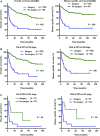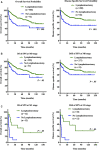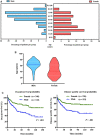Sex differences in solid pseudopapillary neoplasm of the pancreas: A population-based study
- PMID: 32578384
- PMCID: PMC7433837
- DOI: 10.1002/cam4.3180
Sex differences in solid pseudopapillary neoplasm of the pancreas: A population-based study
Abstract
Objective: Solid pseudopapillary neoplasm (SPN) of the pancreas is a rare tumor. This study aims to examine the clinicopathological features and surgical treatments of SPN and compare the clinical behavior and prognosis between men and women with SPN.
Methods: We collected the population data of patients with SPN diagnosed between 2004 and 2017 from the SEER database. The Kaplan-Meier method was used to analyze overall survival (OS) and disease-specific survival (DSS), and log-rank tests were used to evaluate the differences between subgroups. Univariate and multivariate Cox regression analyses were performed to screen out prognostic risk factors of SPN.
Results: A total of 378 patients with SPN were included, with 246 (65.1%) female patients. 1-, 3-, and 5-year overall survival rates were 98.9%, 95.7%, and 93.7%, respectively. Survival analysis revealed that regardless of stage, patients with SPN who underwent surgical interventions still had a significantly better prognosis than those without surgical interventions (P < .001). The patients with lymphatic dissection had a significantly better prognosis than those without lymphatic dissection (P < .001). Moreover, compared with female patients, male patients had significantly poorer OS and DSS (P < .001). Female SPN showed a bimodal age-frequency distribution with early-onset incidence at 28 years and late-onset peak incidence at 62 years, while male SPN presented a unimodal distribution with peak incidence at approximately age 64 years. In female patients, the tumor size in premenopausal females (<65 years old) was significantly larger than that in postmenopausal females (≥65 years old) (P < .001). Clinicopathological characteristic profiles were different not only between male SPN and premenopausal female SPN but also between premenopausal and postmenopausal female SPN.
Conclusion: SPN presents indolent behavior and predominantly occurs in young women. Regardless of stage, surgical intervention is recommended. Moreover, our study is the first large enough study to demonstrate sex-related discrepancies in SPN. Thus, different treatment strategies should be designed for patients of different sexes at different ages and hormone therapy is a promising approach for SPN.
Keywords: SEER; hormone; sex-related discrepancy; solid pseudopapillary neoplasm of the pancreas.
© 2020 The Authors. Cancer Medicine published by John Wiley & Sons Ltd.
Conflict of interest statement
None of the authors have any potential conflict of interest to declare.
Figures






Similar articles
-
Survival and Prognostic Factors in Patients With Solid Pseudopapillary Neoplasms of the Pancreas.Pancreas. 2018 Sep;47(8):1003-1007. doi: 10.1097/MPA.0000000000001112. Pancreas. 2018. PMID: 30036214
-
Solid pseudopapillary neoplasm of the pancreas: Management and long-term outcome.Eur J Surg Oncol. 2017 Jun;43(6):1056-1060. doi: 10.1016/j.ejso.2017.02.001. Epub 2017 Feb 10. Eur J Surg Oncol. 2017. PMID: 28238521
-
Management of solid pseudopapillary neoplasms of pancreas: A single center experience of 243 consecutive patients.Pancreatology. 2019 Jul;19(5):681-685. doi: 10.1016/j.pan.2019.07.001. Epub 2019 Jul 2. Pancreatology. 2019. PMID: 31281058
-
Solid pseudopapillary neoplasm of the pancreas: a rare and atypically aggressive disease among male patients.Am Surg. 2010 Oct;76(10):1075-8. Am Surg. 2010. PMID: 21105613 Review.
-
Malignant Solid Pseudopapillary Neoplasm of the Pancreas: An Orthogonal Analysis.Ann Surg Oncol. 2024 Jan;31(1):475-487. doi: 10.1245/s10434-023-14343-0. Epub 2023 Sep 28. Ann Surg Oncol. 2024. PMID: 37768414
Cited by
-
Solid pseudopapillary neoplasm of the pancreas in a young male with main pancreatic duct dilatation: A case report.World J Clin Cases. 2021 Dec 26;9(36):11382-11391. doi: 10.12998/wjcc.v9.i36.11382. World J Clin Cases. 2021. PMID: 35071569 Free PMC article.
-
Complete enucleation of a complicated solid pseudopapillary neoplasm of pancreas: A case report.Int J Surg Case Rep. 2023 Sep;110:108765. doi: 10.1016/j.ijscr.2023.108765. Epub 2023 Aug 29. Int J Surg Case Rep. 2023. PMID: 37689020 Free PMC article.
-
Endocrine therapy for metastatic solid pseudopapillary neoplasm of the pancreas: A case report.Front Oncol. 2022 Sep 13;12:970142. doi: 10.3389/fonc.2022.970142. eCollection 2022. Front Oncol. 2022. PMID: 36176411 Free PMC article.
-
Cytological Diagnosis of Pancreatic Solid-Pseudopapillary Neoplasm: A Single-Institution Community Practice Experience.Diagnostics (Basel). 2022 Feb 9;12(2):449. doi: 10.3390/diagnostics12020449. Diagnostics (Basel). 2022. PMID: 35204541 Free PMC article.
-
Prognostic Enigma of Pancreatic Solid Pseudopapillary Neoplasm: A Single-Center Experience of 63 Patients.Front Surg. 2021 Nov 22;8:771587. doi: 10.3389/fsurg.2021.771587. eCollection 2021. Front Surg. 2021. PMID: 34881287 Free PMC article.
References
-
- Kang CM, Choi SH, Kim SC, Lee WJ, Choi DW, Kim SW. Predicting recurrence of pancreatic solid pseudopapillary tumors after surgical resection: a multicenter analysis in Korea. Annals Surgery. 2014;260(2):348‐355. - PubMed
-
- Martin RC, Klimstra DS, Brennan MF, Conlon KC. Solid‐pseudopapillary tumor of the pancreas: a surgical enigma? Ann Surg Oncol. 2002;9(1):35‐40. - PubMed
Publication types
MeSH terms
LinkOut - more resources
Full Text Sources
Medical

